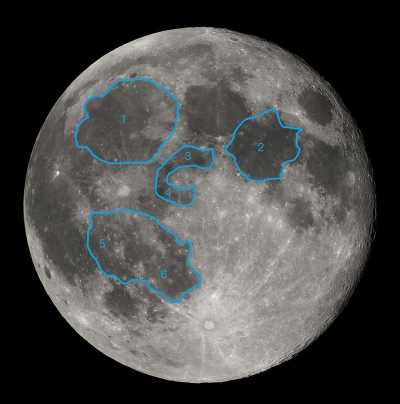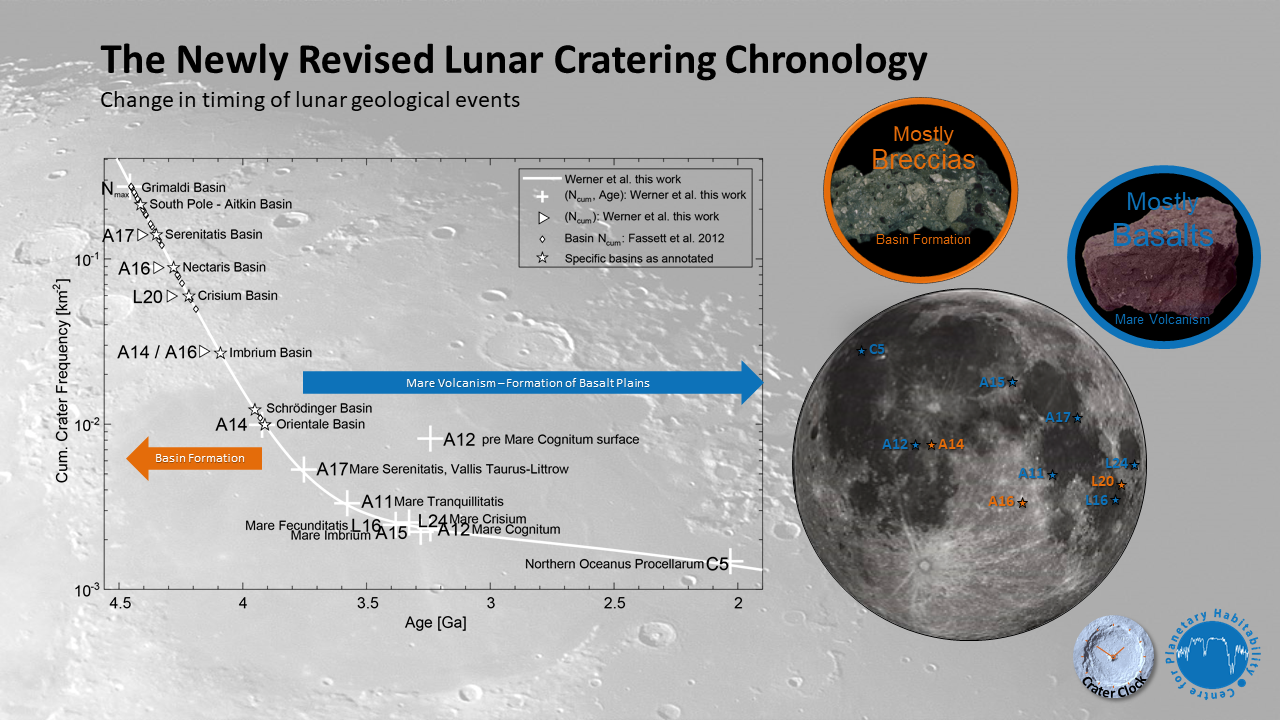In particular, the surfaces around the mysterious "Man in the Moon" (the bright parts in the picture) have become 200 million years older!
"The Man in the Moon"

Humans have interpreted the lunar landscape into familiar forms and created stories to explain them. The formations on the lunar surface can look like a face, and this is what many call the "Man in the Moon".
Source: Royal Museums Greewich
A Norwegian - French research team has been investigating whether it is possible to find at a robust and more reliable time scale that can be used to date the development of planetary surfaces in our solar system.
The number of craters has been important in providing knowledge about how the planets have developed over time.
In 2015, the researchers started the project called 'CRATER CLOCK: Calibration of the Cratering Chronometer for the Earliest Planetary Evolution' with support from the Research Council of Norway over a four years period.
– But it took us four extra years to complete all the tasks, says Stephanie Werner, Professor of Planetology, Department of Geosciences and central in the new research centre PHAB at UiO.
Now we can begin to rewrite the geological development history of the Earth-like planetary bodies in the solar system.
Stephanie Werner
The team presented their findings in two scientific articles in the Planetary Science Journal. They have gone through the model for determining the age of planetary surfaces - and newly revised the Cratering Chronology Model.
Time scales important for defining events
Time is an abstract term, but is important for linking actual events to a time scale. For modern times, measured in the amount of one second, we use the radiation of an atom, for example the cesium-133 atom.
To determine the age of rocks, we can count the decay products of radioactive elements in them, such as uranium or potassium, and relate these to the isotope half-life. But what about planets far away from Earth?
– When we have to determine the age of planets, we have to use indirect methods. One of them is to count the number of craters per area. The more craters that a surface has accumulated, the older it is, and where several craters overlap, the one at the top is the newest, explains Stephanie Werner.
Unlike previous work, the researchers behind the new study use spectral information, i.e. assessment of light and shadow conditions at the actual landing sites for the Apollo-, Luna- and Chang'e-missions.
In addition they use spectral and mineral data from lunar samples (collected during the Apollo, Luna and Chang'e missions) to define the outline of the counting units where they count the craters.
In this way, the researchers describe counting areas in a unique way, which at the same time define the samples that can be selected for the calibration age.
Compared to previous models, the new calibration pairs (crater density vs age) suggest a monotonically decreasing and, more importantly, an overall lower flux of cratering projectiles from space, such as asteroids.

Parts of the lunar surface significantly older than previously thought
The newly revised model of crater counts across the lunar surface suggests much older areas than some of the current crater chronology models. Actually up to 200 million years older.
Transferring this model to other solid-surface planetary bodies also involves ageing dating of these surfaces. These are, for example, planets, moons and more.
This means that all previous comparisons between meteorites, rocks from, for example, Mars or the Moon, found on Earth, and areas of Mars or the Moon that were thought to be the source of these meteorites, should be reassessed. This is because the age of the surface has been revised.
– Also assessments made about the geological events that characterise the surface of planets, such as volcanic activity, rift formations, rivers and glaciers, may now be older than dated with previous models, says Werner.
Important for further research
Knowledge of a planet's surface and age is important, for example, to assess whether the creation of life has been possible. At the new Centre for Planetary Habitability (PHAB), a Centre of Excellence at the University of Oslo, Department of Geosciences, this is a central question.
The calibrated crater clock 'Cratering Chronology Model' makes it possible to study the evolution of planets and compare them using a time scale.
– This will be very exciting, because all times and ages have changed.
For example, was Mars actually wet long enough to develop life forms before it turned into a cold stony desert?
– Or: When did the planet Venus become the court of hell?, asks Stephanie Werner, who is looking forward to properly getting started with the research at the PHAB centre, which was established this summer.
She says that there is great deal of interest in the moon. The Indian spacecraft "Chandrayaan-3" successfully landed on the Moon on August 23. The Russian spacecraft "Luna-25" was not so lucky, and crashed into the lunar surface earlier in August. In the near future, Japan will also launch a spacecraft on a lunar mission.
References:
Bultel, B. S.C. Werner. 2023. Sample-Based Spectral Mapping Around Landing Sites on the Moon - Lunar Time Scale Part 1. The Planetary Science Journal, Volume 4, Number 8. DOI 10.3847/PSJ/acdc15
Werner, S.C., B. Bultel, T. Rolf. 2023. Review and Revision of the Lunar Cratering Chronology - Lunar Time Scale Part 2. The Planetary Science Journal, Volume 4, Number 8. DOI 10.3847/PSJ/acdc16
About the Crater Clock
Project description of CRATER CLOCK: Calibration of the Cratering Chronometer for the Earliest Planetary Evolution. The project started in 2015 with support from The Research Council of Norway.
